Text
GOTG Review: Astria Ascending
This is the next game in my Backlog Roulette series, where each month I spin a wheel to randomly select a game on my massive backlog that I must play (though not necessarily to completion). These wheel spins occur on the monthly preview episodes I co-host with my friends on The Casual Hour podcast.
There’s a phenomena about robots you’ve probably heard of before. It’s called the uncanny valley. The idea is the closer a robot looks and acts like a human, the more its inaccuracies are scrutinized and criticized by real humans. The reasons could be myriad — it could be the way it looks or sounds or moves or something else entirely — but the important thing is that it’s not…right. Astria Ascending lives in its own uncanny valley. But it’s not one of being human, rather, it’s one of being a JRPG classic.

There’s another saying famous saying: “If it looks like a duck, swims like a duck, and quacks like a duck, then it probably is a duck.” Astria Ascending certainly looks like a great JRPG, its Vanillaware-like character design is striking, with a number of unique races from the beastly feline Arktans to the angular and serpent-esque Zeft. The art direction in general is often a sight to behold. The hub area especially has a real electricity about it, with many gorgeous structures.
It swims like a great JRPG as well. Opening the menu reveals a wave of systems and mechanics. Each of the eight party members has their own starting class, equipment type, skill tree and abilities. Combat sees you use four of your party members at any one time, though you can swap out members mid-battle for strategic advantages. There are a suite of buffs and debuffs that can be applied to your team or to enemies. There’s a summon system. There’s even a Bravely Default-style system that lets you spend resources for more powerful attacks in a single turn.

And hey, it even quacks like an RPG classic. The premise is undeniably cool: The world is protected by a faction of eight demigods, people from around the world who were drafted into service and given incredible power, but also given just a few short years to live. And the current group — your playable characters — are just three months away from a pretty permanent retirement as they work to protect the world fully knowing they won’t be around to see the fruits of their effort. The writing and voice acting (both in Japanese and English) are well done. And musically, composer Hitoshi Sakimoto, who has contributed to Final Fantasy Tactics, Final Fantasy XII and 13 Sentinels: Aegis Rim does solid work here as well.
But unfortunately, looking, swimming and quacking like a great JRPG is not enough to make you one. And it’s in the details where Astria Ascending falls.
Ulan, seen here waving her arms like some kind of wacky inflatable tube man.
The game looks beautiful…in stills. Characters’ idle animations are so fast and so wild they become distracting. Walking and running animations are awkward too. There’s a real “Live 2D” look to everything going on here that just is devoid of personality. Battles don’t fare much better as animations and effects for spells and attacks are weak and flat. It’s such a bummer seeing cool characters move in such lifeless ways.
Astria Ascending does have a wide array or systems though…too big of an array, in fact. You start the game with your full party of eight, which means you have eight classes, each with their own massive skill tree to attend to. And before you can unlock much of anything on one of these trees, you’re given additional access to a choice of three upgraded job classes per character that open up a second full skill tree. And later you’re given sub jobs and support jobs, which create even more headaches. I love tinkering with character builds, but this is just too much. Oh, and those upgraded job choices are permanent, so you better be happy with your picks.
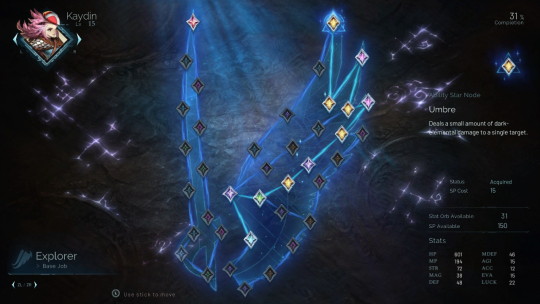
This skill tree is fine, but when every one of the eight characters has two of these each (and most of the things on it are flat stat buffs), it becomes both overwhelming and monotonous.
And all of this mechanics and systems just end up making the game’s many, many fights long and tedious, often with little reward. It got to the point where I turned the difficulty down to its lowest setting just to mercifully pick up the pace.
When you’re not fighting, you’re walking around incredibly simple and bland Metroidvania-like environments. The structure feels a lot like Vanillaware’s Muramasa: The Demon Blade, where dungeons are made up of 2D side-scrolling rooms that can branch off in multiple directions. But each of Muramasa’s screens are visually distinct and built for dynamic platforming and action combat. Astria Ascending’s rooms all look the same and you mostly just hop around to solve the most basic of puzzles.

Every dungeon ends up looking this spartan, with identical room connecting to identical room. It's easy to get lost.
And as for the quacking part, while the premise is cool, half the game is spent going back and forth among everyone’s hometowns, solving very similar problems before going back to the main hub to report in. It feels less like a grand adventure or unravelling a mystery and more like running errands with no payoff.
The music is also CONSTANT. There are no quiet moments. There is very little up or down. The tracks are fine, but they're implemented so poorly. They're just always there, sometimes drowning out the voice acting. And those voices, while nice performances, sound awfully similar (especially for the female English voices), and since the camera is almost always zoomed out, it can be quite difficult to know who’s talking.

The speech bubbles are also of little assistance when it comes to knowing who's speaking.
At this point, I suppose it’s clear that I didn’t like Astria Ascending, but I do find it to be an interesting case study for what makes a JRPG good or bad. Astria Ascending pretty strictly follows the formula of classic JRPG design, but while it hits the right notes and plays them in the right order, there’s just no soul to this music. Even if developer Artisan Studios addressed all of the issues I listed above, I’m still not sure the game would be good. Because it would still be missing a thousand little details that even I can’t so easily put my finger on.
Astria Ascending is not a bad game, not in a technical sense anyway. It’s just one that lacks heart and passion. It’s a photocopy, an amalgamation of good things from other games without the understanding of what those good things mean or how they should interact.
It’s uncanny. And once you see it, you can't unsee it.
2 notes
·
View notes
Text
GOTG Review: Wasteland 3
This is the next game in my Backlog Roulette series, where each month I spin a wheel to randomly select a game on my massive backlog that I must play (though not necessarily to completion). These wheel spins occur on the monthly preview episodes I co-host with my friends on The Casual Hour podcast.
The first big choice you make in Wasteland 3 is selecting your initial two characters. You can pick from a handful of pre-made pairs (according to the guides I read after the fact, you should really go with Yuri and Spence, as they have great exclusive accessories, as well as the first aid ability that comes in very handy in the tutorial missions. You can always replace them later in the game and keep their starting goodies), or you can build your own from scratch.
When given the option (even when in retrospect, it was the wrong choice), I’m always going to make my own character. I don’t care how much better the standard Commander Shepard character model looks, I’ll take my weird-ass dude any day…even if he accidentally ends up looking like Conrad Vernor.
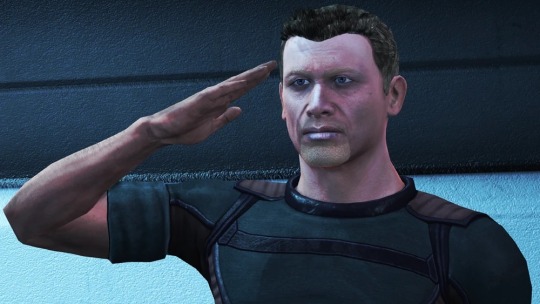
I spent a good portion of Mass Effect thinking that the superfan Conrad Vernor character was supposed to look like your Shepard on purpose before realizing my mistake.
So I made my two characters: Minami, an ice-cold sniper who prefers to keep to herself, but has a way with machines. And Liu, a grizzled veteran who picks locks, disarms traps and gets up close and personal with a submachine gun.
Then you get into the game itself, which is an isometric RPG in the vein of classic Fallout and Baldur’s Gate-style games. It’s pretty good! Still a little glitchy, despite having come out over three years ago (I did lose about three hours of play due to a save error, as well as dealing with a couple of crashes and getting stuck in a door), but it’s fun. It’s got a sense of humor that is willing to be silly — at one point you can fight a giant animatronic Ronald Reagan, complete with laser eyes — but it never reaches Borderlands-levels of grating. And the RPG mechanics are always fun to tinker with as you discover skills, weapons and gear that make for a variety of surprisingly viable builds.
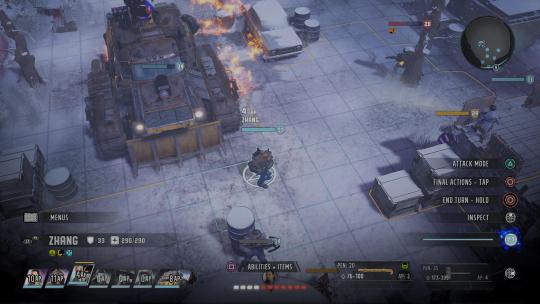
It shocked me how good Zhang, my melee bruiser, was in my team composition.
As you play Wasteland 3, you will eventually run into some named characters who will join your squad, as well as be given the opportunity to build even more characters from scratch (you can only carry six squad mates at a time though, the others can be swapped in back at base.) And this is where I found Wasteland 3 to get very interesting.
On one hand, these named characters are quite useful, not just for the unique weapons and items they come stock with (similar to the premade starting characters), but also because they are a real part of this game’s world. Darius Kwon, an early companion, is one of the Marshals in your hub area. He’s lived and worked here, and knows pretty much everybody. When you go and talk to the cranky landlady in the apartment building on the east side of town, he has dialogue with her that reveals this isn’t the first time he's had to make a house call here. He adds a lot of commentary and color as you meet more people in town, which helped me to better immerse myself into the world of Colorado.

And yet, I resented every minute he was in my squad. Because Marshal Kwon was not my character. And I had decided this wasn’t his story, nor was it the shotgun-toting drunk, Scotchmo’s story, nor the young sharpshooter, Lucia Wesson’s, all recruitable named companions. Each of these characters were only getting in the way of the story I was building for myself. And while it made problems for me, I did find it to be an interesting needle developer inXile tried to thread.
The way I see it, there are three kinds of character options when it comes to games. The first are the fully-fleshed out roles — Mario, Master Chief, Sonic the Hedgehog. These characters have pretty set abilities. Your only outlets for expression are the way you choose to execute those abilities, like whether to pick up the Needler or which route you take up the hill in Bob-omb Battlefield. It’s great for leading a player through a story, or giving them a specific experience, but it’s also quite rigid. This is Mario's story, you're just helping him through it.

I never owned a copy of Super Mario 64 growing up, but I played this stage so many times going over to my friend's house. It's on the backlog roulette wheel though, so maybe someday I'll see past this initial area.
Then there are games where you’re given near total freedom to inhabit the role or roles you want — XCOM: Enemy Unknown, Dragon Quest IX (the best DQ, by the way), World of Warcraft. You build your character(s) from the ground up: What they look like, what their specialties are, sometimes even what goals you want them to pursue. But that freedom comes at a cost. It’s hard to tell a compelling narrative or build interesting challenges as a developer if your player characters can look like or be anything. There’s just not much for them to grab onto, which can lead to something that feels altogether passive or disengaged. While the player might personally get attached to one of their characters in XCOM, the game itself cannot, as that character might get permanently ripped apart in the very next mission.
And then you’ve got games that do a little of both. This is where pretty much all Bioware or modern Fire Emblem games go. You get some choices about your main character, but they still need to fit into the right box or boxes the devs have made for them to work within this world. These are sometimes labeled as “self-inserts.” You get to make “you,” but everything else is predetermined. In Fire Emblem: Awakening, you can make Robin look however you want and put them in basically any class, but Chrom’s always going to be Chrom, and the story is going to be the story, even with your slight influence. Sometimes this balance works great, but other times you can feel too restricted by the game's options while also not getting as crafted a narrative as you'd like.
Wasteland 3 oddly tries to pull from column B and column C at the same time. You could eventually have a squad of six pre-built companions. Or you could create six custom characters. Or you can mix and match any combo of the two. I think that’s wild. Because while a self-insert-style character can make sense on its own, it really starts to shatter the illusion when you add a second one (or a third, or even more).

This is the squad I found myself running for most of my game. Lucia and Kwon are premade companions. the other four are my own creation.
When you're a self-insert character, you understand that many times, you're out of your element, and these other characters in and out of your party have a reason to catch you as the player up to speed (through your self-inserted character) on the world and how things work. And when you've got a whole army of custom characters, you realize the onus is on you to build that story in your mind, attributing meaning to emergent game actions. You put your classmates into Oregon Trail, and then you get to imagine those real people getting dysentery (this is also true for more procedurally-generated games like Dwarf Fortress. Oftentimes, the player is left to find their own meaning out of these semi-random happenings.)
But having my squad of four meticulously-crafted death dealers constantly be spoken for by two people I had zero attachment to, but were to be seen as equals? I just couldn't square that circle, and it continued to bug me during my entire playthrough. It felt wrong to kick those characters out and miss out on their potential world building, dialogue or voice acting, but at the same time, they just didn't belong in this idea I had created for myself.
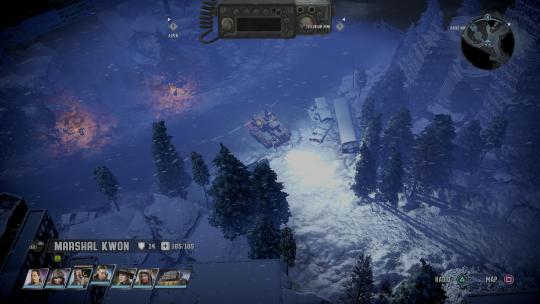
Listen, I really enjoyed my time with Wasteland 3 (it’s hard not to have a blast when you craft a revolver with incendiary rounds that makes enemies explode when you kill them), and I absolutely recommend you check it out. You may not have the same hangups I do when it comes to the characters. Or you may not worry about missing a little bit of insight into the world by having a full custom squad.
Am I overthinking this one? Did you have a similar fourth-wall-breaking while playing Wasteland 3? And are there any other games where this kind of split between custom and developer-made characters is so even?
1 note
·
View note
Text
GOTG Review: Pokemon Emerald Rogue
This is the next game in my Backlog Roulette series, where each month I spin a wheel to randomly select a game on my massive backlog that I must play (though not necessarily to completion). These wheel spins occur on the monthly preview episodes I co-host with my friends on The Casual Hour podcast.
Pokemon is a series that is near and dear to me, but since X & Y, it feels like the direction Game Freak has gradually taken the franchise in a direction that diverges from what I want out these games. The move to 3D was inevitable, but it has also made the games clunkier and less vibrant as a result. And while the transition to more open-world gameplay elements has been intriguing, it’s added an aimless quality to exploring the environments that often leaves me cold.
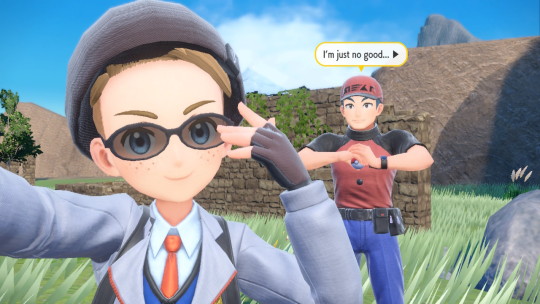
I know, Pokemon Scarlet. I know...
If you like the new style of Pokemon games, that’s great. I’ve played both Sword and Scarlet and found them to be generally decent times. But I rarely think about them outside of their initial playthroughs, and for the first time in my life, I decided to skip the new mainline content with the release of Scarlet & Violet’s DLC.

Look, you can't say I didn't give the new games a shot.
Instead, I’ve found myself thinking more and more about the Pokemon romhacking community. Pokemon romhacks primarily take place in the third generation of Pokemon games, those found on the Game Boy Advance (there are also quite a few hacks from the Game Boy’s Gens 1 and 2, and a handful from the DS era of Gens 4 and 5, but the GBA games appear to be the sweet spot for hackers). These romhacks experiment in all sorts of ways, from difficulty mods like the “Kaizo” games, to games with brand new stories, regions and Pokemon like Pokemon Vega. There are games that attempt to recreate the Pokemon anime or manga, and others that flip the concept of Pokemon on its head, like in one hack where you play as a member of Team Rocket and steal other people’s Pokemon. Many of these hacks incorporate more contemporary ideas from Game Freak’s work — Mega Evolution, new forms and types, Z-moves, etc. — but keep them within the general framework and design space of the Gen 3 games, which gives them all a strong foundation upon which to build (also, using the GBA games as a base means these romhacks play perfectly on my Analogue Pocket.)
Pokemon Emerald Rogue is probably the most extreme and interesting romhack I’ve played yet, totally upending the formula of Pokemon by converting the game into a roguelike similar to titles like Hades or Rogue Legacy.
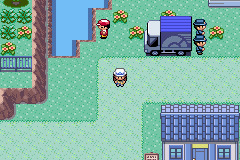

Emerald Rogue (I played Pokemon Emerald Rogue EX v1.3 in case any of what I’m about to say changes in future updates) spits you out in an empty hub area save for three buildings — a config house where you can change some settings, a lab where you can choose your first Pokemon and a building to the north where you can start a run.
The three Pokemon you have to choose from are random. My choices were Omanyte, Squirtle and Clampearl. Knowing survivability and flexibility were probably the most important things for a roguelike, Omanayte and its dual typing of rock and water seemed to be the right choice. Then I went on my first run.
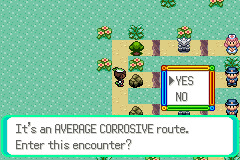
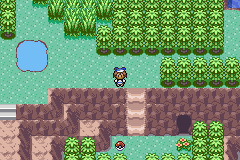
A run in Emerald Rogue starts you in a weird-looking overworld. This is essentially a decision tree on where to go next, like in FTL or Slay the Spire. The choices in front of you have names like “average gloomy route” or “mighty wet route.” These names correspond to the challenge of that route and the general preponderance of Pokemon types that you’ll find there — a mighty sharp route for instance will have more trainer battles and feature more steel-type monsters.
Once you choose a route, you’re put into a modified version of a route you’d see in a traditional Pokemon game. There are grass patches, items strewn about and trainers looking for battles. You start with five pokeballs and the catch rates appear to be much higher than usual, making adding new team members relatively painless. Like in a typical Pokemon game, catching a Pokemon adds it to your party, but if you catch more Pokemon than your team of six can hold, you must immediately release one — there’s no PC box with which to hold extra creatures in runs.
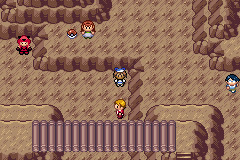
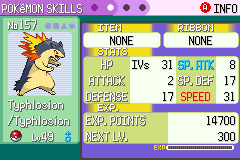
You’ll also notice that when you defeat wild Pokemon, you gain levels FAST, and the exp all item makes sure your whole team is leveling speedily as well. There’s very little grinding in Emerald Rogue. Instead, the game introduces level caps for each area, asking you to make quick decisions about your team’s movesets as they learn new abilities rapidly, then challenging you with trainer battles you can’t just overcome by outleveling them. And if in one of those battles, you happen to lose a Pokemon, it doesn’t just faint, it’s automatically removed from your team at the end of battle, losing any items and investment you put into that Pokemon, but leaving you with a slot open to add another ‘mon as you continue.
Once you complete a route by getting to the end, you advance on the overworld tree and pick another route. There are also various other stops along the way, such as healing stations, shops for pokeballs, TMs and battle items, a lab where you can find your previously defeated Pokemon (though picking them back up often leaves you with a burden, like having to pay 10% more on items at shops during that run), tough trainer battles where you can win special items and take one of their Pokemon if you win or dens where a rare Pokemon is available to be captured (either legendaries or Pokemon with hidden abilities, like a Heracross with Moxie — a passive ability that raises its attack after every Pokemon it defeats in a battle).

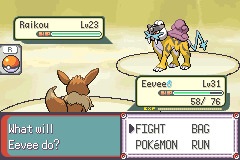
At the end of an overworld tree is a gym battle, where you can quickly raise all your Pokemon to the level cap if you haven’t done so already, or heal up (free at first, but gets expensive quickly,) before facing off against a random Pokemon Emerald gym leader. These gym leaders keep their type affinities — Wattson still uses electric types, fire for Flannery, etc. — but their teams have been enhanced with competitive movesets and overhauled AI. These are tough battles, and while they’re not Kaizo-level difficult, they are meant to trip you up. Also, the battles are on “set” mode, so you don’t get the advantage of a free switch anytime you defeat an opposing Pokemon, furthering the strategic bend of these battles.
Beating a gym leader permanently nets you an HM, which work a little differently here: You don’t have to teach these moves to a Pokemon to use them outside of battle (and even if you do, they can be deleted freely in favor of other moves, unlike traditional Pokemon games,) and they’re mostly used to access shortcuts or alternate paths in the routes. Then the Pokemon that survived the battle will get fully healed and you’ll be put on a new overworld tree to do it all again. Beating the game requires you to defeat all eight gym leaders, all four Elite Four members and two champions, meaning 14 loops total in a single run, and the difficulty ramps up with each loop.

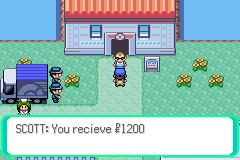
If and when your team gets wiped out, you’ll be taken back to the hub area, and you’ll lose all the items, money and Pokemon you had on your run (save for the HMs you were able to unlock as well as your starter, though it’ll be back to its original level 5 state without any of the moves you taught it). Then you’re given money and items proportional to how far you got in your run. This is where the roguelike becomes less like a Spelunky and more like a Hades — anything you do with this money and these items in the hub is permanent. Shops that open in the hub will sell you TMs, so I could buy Ice Beam and equip it to Omanyte for use in all future runs (protip: don’t teach your TMs in the hub world. Instead, hold them until you start a run, and then teach it, so you have the option to teach it to something else later). They can also sell pokeballs, potions and battle items so you’re better stocked for any and all future runs.
There’s also a Safari Zone that eventually opens up, allowing you (for a price) to go in and permanently catch Pokemon that you’ve caught on your runs before (though legendaries won’t be added to that pool until you progress much further into a run). While you can only take one Pokemon with you into any one run, you do get a PC in the hub area, so you can keep all the Safari Zone Pokemon you catch and swap them out as you please (for my second run, I benched Omanyte and brought in Houndour instead).

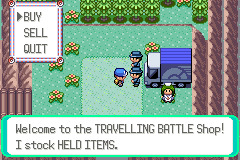
That is essentially what Emerald Rogue is all about. Now, you may have been thinking of a question during all of this, a question I asked myself many times as I played Emerald Rogue — isn’t this just basically a Nuzlocke, where you play a game of Pokemon that incorporates permadeath and other self-imposed rules? In many ways, yeah, that’s exactly what it is, a Nuzlocke where instead of imposing the rules on yourself, the game automatically accounts for and streamlines those rules for you.
But I think there’s something more at play here. Nuzlocking a traditional Pokemon game is often about mastery of that specific title. When playing FireRed, you know you have to come up with a counter to Brock or Misty or the trainer with two Geodude and a Graveler who likes to spam Self Destruct in Rock Tunnel. You know that if you can just get past this next part, you'll get the TM for Psychic. And you know exactly where you can find a Magikarp to evolve into a Gyarados. In Emerald Rogue, you don’t know what the next trainer or gym leader will bring, so the mastery required is of the pure battle mechanics themselves. The items and TMs and Pokemon you have access to are random (or curated by you in the hub), forcing you to make do with what you have or what you can scrounge up. It’s a game about anticipation and reaction, not one of planning and strategy. That’s why I think while they play in similar spaces, each of these ways of playing Pokemon is valid and interesting in their own ways.
Emerald Rogue has innovated on the design of Pokemon is a way Game Freak would almost assuredly never do. It goes against the philosophy of contemporary Pokemon games (hell, Nintendo and The Pokemon Company barely acknowledge the existence of Nuzlockes in the first place, and recent games have made design decisions that make that style of play almost impossible.) If you have become disillusioned by modern Pokemon games, if you’re looking for an interesting challenge that isn’t Kaizo-level impossible or if you want to remember just how damn good Pokemon can be, Emerald Rogue is a triumph of the form and well worth your time. Now excuse me, I just caught a Galarian Zapdos in the Safari Zone and I can't wait to try it out on my next run.
9 notes
·
View notes
Text
GOTG Review: Hypnospace Outlaw
This is the next game in my Backlog Roulette series, where each month I spin a wheel to randomly select a game on my massive backlog that I must play (though not necessarily to completion). These wheel spins occur on the monthly preview episodes I co-host with my friends on The Casual Hour podcast.
Both of my parents were educators at my elementary school (they're retired now.) Mom was a 3rd grade teacher and Dad taught gym. They both would stay after classes were over to work on lesson plans or grade papers or move equipment, and I got to freely choose which one to spend time with before we got to go home. With Dad, I would mostly practice free throws in the gym (though I never got any good at them). But with Mom, I’d often get to play on her computer (when I wasn’t watching Digimon Adventure on her classroom TV.
That was probably my first real experience with computers. I’d play things like Oregon Trail II (the best one, by the way) or an awful typing program called PAWS featuring a freaky Cheshire-Cat-like mascot. But sometimes, I would load up Netscape Navigator and just poke around on the late ‘90s internet.
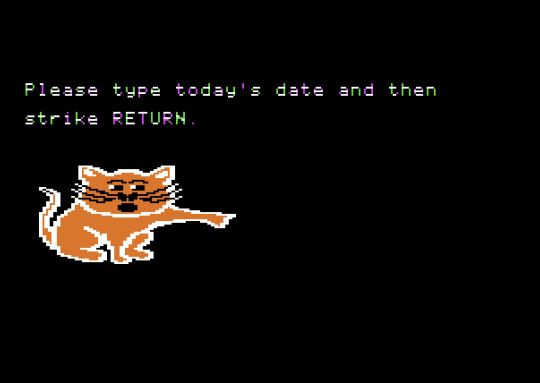
I hated this cat so much as a kid.
I only remember bits and pieces of that time online. A Sokoban block-pushing puzzler, a Super Mario Bros. fan game with all-new levels, some first-person hovercraft racer that had multiplayer LAN capabilities (I’ve never been able to find that game since, it’s definitely not Hover! by Microsoft.) a fansite for the Sonic Underground cartoon. Even with my fragmented memory, I remember the joy and adventure I had just digging around. Anything could be around that next corner, and that was half the fun.
Hypnospace Outlaw is the closest I’ve ever come to reliving those formative computer experiences. Set in an alternate 1999, you are thrust into Hypnospace — an internet stand-in that’s part GeoCities and part forum chatroom — and are asked to moderate and police this online Wild West.
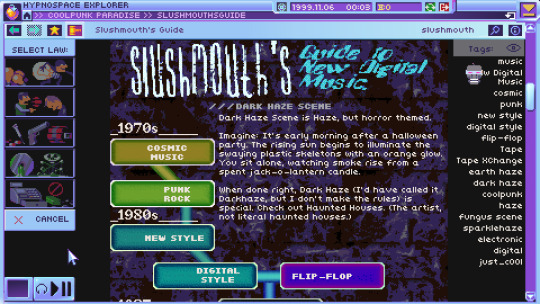
Developer Tendershoot has nailed the tone and aesthetic of this era. The highly compressed bitmap images, the way pages auto-play (incredible) music when they load, the terrible, terrible fonts, the fileshare servers that are completely inscrutable unless you know exactly what you’re looking for — it’s all just perfect. And it’s not just Hypnospace. The game has its own little desktop computer experience complete with email, virtual pets, a download manager and more. It reminds me of Cibele or Her Story, but much more freeform and robust.
But all that is just aesthetic — the game itself is pretty cool too. As a Hypnospace moderator, you’re given little jobs as you explore the various pages and zones of the browser: Take down some copyrighted material here, censor some threatening speech there, find some lost files that are hanging around…somewhere. Some of these tasks just require you to pay close attention to the pages themselves, while others force you to put on your hacker cap as you cross reference ID codes with unlisted pages, crack passwords or decrypt files, all while a corporate conspiracy bubbles up around you.
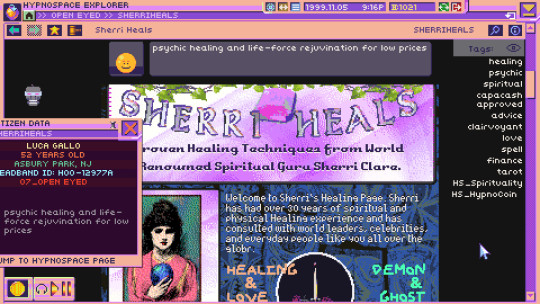
It’s truly satisfying to use your online sleuthing skills to their fullest. And whether you’re stopping a virus from breaking the virtual world or just banning a kid who can’t seem to stop making offensive webcomics, you just feel this sense of power.
In many ways, Hypnospace Outlaw the platonic ideal of the concept of late-90s computing. I do wonder if that hyper-specific aesthetic and mechanics gives it too narrow of an audience, but as someone who is part of that narrow audience, I found my experience with it to be incredibly fun. And it’s one I won’t soon forget.
5 notes
·
View notes
Text
GOTG Review: AI: The Somnium Files and Famicom Detective Club: The Missing Heir
This is the next game in my Backlog Roulette series, where each month I spin a wheel to randomly select a game on my massive backlog that I must play (though not necessarily to completion). These wheel spins occur on the monthly preview episodes I co-host with my friends on The Casual Hour podcast.
Not every game on the Backlog Roulette wheel is going to be a winner, and they’re not meant to be. Many are games I curiously picked up on a sale or remembered from an old tweet or offhand comment from a friend.
That was the case with AI: The Somnium Files. Someone described it as a Persona adventure game, and that was good enough for me to snag it on the cheap and hold onto for a rainy day. But it only took a couple of sessions to realize that while The Somnium Files isn't really what I had in mind.

AI is a detective game at its heart. You embody Special Agent Kaname Date, an acerbic yet disaffected gumshoe with a missing eye. In its socket instead is an AI robot called Aiba who pulls double duty as a sort of Zelda Navi-like character while also giving you a host of super powers (like being able to see through objects or hacking into phone records remotely). But despite having these tools available to you, it only makes the moment to moment gameplay even more of a hunt-and-peck ordeal.
I just couldn’t get into it, especially once my AI eye turned into a scantily-clad anime waifu for little to no reason. The writing goes into a very creepy and horny mode once this transformation occurs, and that was enough for me. Maybe if the game was more fun to play, I’d have been able to overlook it, but after already being bored and frustrated by the larger mechanics, it ended up as the final straw.

Reeeeeal classy, Date.
So instead of slogging through AI: The Somnium Files any further, I put it down in favor of a different Japanese detective game that also happened to be on the Backlog Roulette wheel. One much more stripped down and straightforward (and much less horny), Famicom Detective Club: The Missing Heir.
FDC is a series of two mystery games that (as the name implies) released on Nintendo’s Famicom console. While the 1988 and 1989 originals never saw a release outside of Japan, Nintendo and developer Mages remade the games from the ground up to release worldwide on the Nintendo Switch in 2021.

What a difference 30+ years can make.
Loading up the first game, The Missing Heir, the interesting mix of new and old hits you immediately. Gone is the pixel art of the 1988 version, replaced by hand-drawn backgrounds and anime-inspired character designs. The chiptune music tracks have all been updated to more modern instrumentation as well. But ever-present is the simple list of actions and dialogue options of the UI.
And it plays like an old adventure game too, requiring you to select some of the same dialogue options multiple times (or in specific, untold sequences) to unlock further options to progress the story. Occasionally, the game will highlight options in yellow to tell you of new options that have just opened up by some trigger, but that is not always the case, nor do these highlighted options always further the plot either. I can appreciate how a detective game should leave the player room to actually make deductions on their own, but oftentimes in The Missing Heir, I would end up cycling through every dialogue choice multiples times, just crossing my fingers I would finally hit upon the right sequence or frequency. Eventually, I would give in and pull up a spoiler-free guide to cut down on the repetition and get through the story.
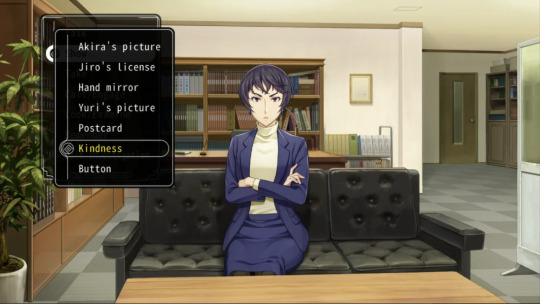
Because unlike AI: The Somnium Files, Famicom Detective Club: The Missing Heir actually has a fun story to uncover. Originally being a Famicom game, it’s no Sherlock Holmes, but there are ample rug pulls and intrigue, culminating in a twist you can probably see coming, but maybe not in quite the way you expected. Despite being a game centered around a murder (or two, or three), it’s just kind of a pleasant little experience to work your way through. It’s even got me interested in playing its prequel, The Girl Who Stands Behind.
AI: The Somnium Files may have ended up being a bummer for me (though other people seem to really enjoy it, according to numerous reviews), I’m glad it led me to a game I enjoyed much more. And even better, I was able to trim two games from my backlog this month. That's value, baby!
2 notes
·
View notes
Text
GOTG Review: Gunpoint
This is the next game in my Backlog Roulette series, where each month I spin a wheel to randomly select a game on my massive backlog that I must play (though not necessarily to completion). These wheel spins occur on the monthly preview episodes I co-host with my friends on The Casual Hour podcast.
I always thought Gunpoint was cool. A puzzle-platformer with heavy stealth elements that saw you bounding up buildings with Superman-like leaps and hacking into electronics to sabotage the guards blocking your way, Gunpoint had a great hook. It also had a fun story behind it as the developer, Tom Francis, was a PC Gamer UK editor who built the game in his spare time, having been inspired by the mostly-one-man effort of Derek Yu’s Spelunky.

There was only one small problem with Gunpoint: I didn’t have anything to play it on. Gunpoint, similar to Francis’ equally cool follow-up game Heat Signature (which I have still yet to play) was locked to Windows machines. So I waited for…Jesus, has it really been 10 years? But now that my good friends (and Casual Hour co-hosts) have built me a PC — and the Backlog Roulette wheel deemed it — it was finally time to play a game I’ve been waiting a decade for.
Anticipation is a funny thing. It can warp perceptions, exaggerating the littlest details (both good and bad) until your expectations could not possibly be met. I remember loading up Mother 3 and not grasping the rhythm-based combat to the point of putting the game down, despite having been enthralled by its world and characters for the longest time. Finally getting to play Final Fantasy VII having never owned a PS1, I was stunned by how much I hated the Active Time Battle System, which left a terrible taste in my mouth as I slogged through combat to get to the parts of that game I did love. I was really worried about similar possibilities going into Gunpoint. Here’s this indie, solo dev game that’s got a 3.5 hour measurement on HowLongToBeat.com. And yet, I’ve let the ideas of what this game could be simmer and brew in my mind for 10 whole years!
So I sit down, open up Steam and brace myself for what comes next. And what comes next is…a really good game.
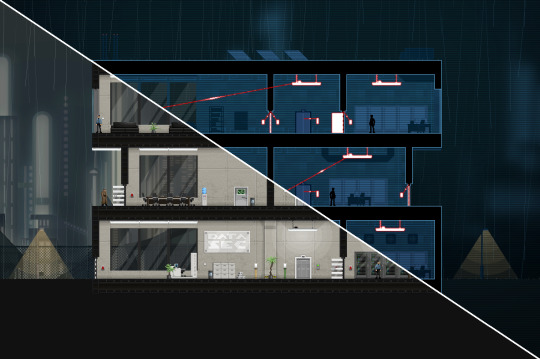
It’s as simple as that. Gunpoint rules. The physics of holding your left click to power up your jump, the way you can break through plate glass windows with the right amount of force (an amount that’s not explicitly stated, yet intuitively felt), the stringent stealth requirements paired with the multiple options for quick resets: It all connects together like a dream.
The only thing that didn’t click with me were the controls, but that is certainly more in part to my lack of experience gaming with a mouse and keyboard rather than the developer’s layout choices. And as Gunpoint more often leans toward methodical pre-planning over twitchy action, even my weak WASD skills were able to pass muster.
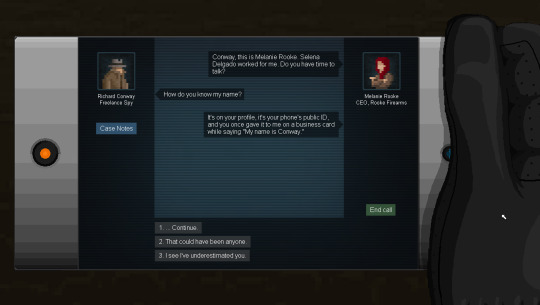
But what stands out for me most is Gunpoint’s sharp writing. I suppose that shouldn’t come as a surprise be written by a guy who was already writing professionally, but the text in Gunpoint is funny and kinetic and smart. Your character, the detective Conway, sends and receives messages with multiple clients, some of whom treat him as a hero and friend whereas others are cold and rude. And you’re given some flavorful options of how to respond. I role-played my Conway as a capable doofus, a kind of Sterling Archer minus the crassness. While the amount of dialogue is a fraction of what you’ find in a Mass Effect game, for my money, Gunpoint has it beat in terms of quality.
Gunpoint’s final trick is my favorite though. It’s a bit of a spoiler, so this is your warning to check out now and go play the game yourself. It’s never more than $10, and often much cheaper. I think it’s totally worth playing.
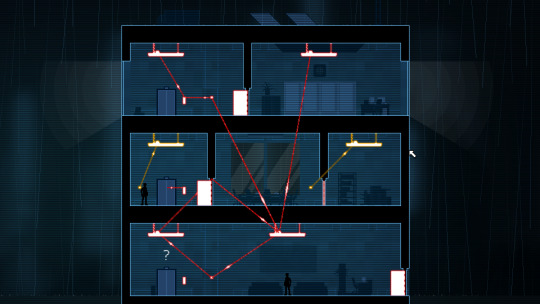
Once you complete the final mission in the game, Conway starts to publish a blog. And just like with the dialogue, you get the option to, uh, smooth over some of the details to put you in a better light. Or you can be completely honest. However you choose to complete the post, when you hit publish, the game instantly closes itself out, and opens up a page in your browser, showing you the finalized blog. On one hand, the game is just taking your stats and and choices and generating a custom little webpage with them. It’s nothing that technical. But it’s a moment of immersion I found intensely cool, bringing the game outside the bounds I had anticipated for it.
And so a 10-year journey comes to a happy end. Let’s see what the next game from the wheel has to offer.
2 notes
·
View notes
Text
GOTG Review: Code Name: S.T.E.A.M.
This is the next game in my Backlog Roulette series, where each month I spin a wheel to randomly select a game on my massive backlog that I must play (though not necessarily to completion). These wheel spins occur on the monthly preview episodes I co-host with my friends on The Casual Hour podcast.
If you know me at all, you know I love Intelligent Systems. They’re a developer who has made some of my favorite games and franchises of all time — Fire Emblem, Advance Wars, Pushmo, WarioWare, Paper Mario, the Super Nintendo port of SimCity, Tokyo Mirage Sessions #FE. With this many bangers, you start to think they just can’t miss.
But they can miss. And sometimes, they miss hard.

Shadow president Lincoln is one of the few high points.
Code Name: S.T.E.A.M. is one of those hard misses. On paper, the pitch is compelling: a 3DS turn-based strategy game where you take a steampunky, alt-history crew of folklorish and literature legends led by Abraham Lincoln, and fight off an incoming alien invasion. I mean, that sounds so bombastically dumb and fun. And then you start playing it.
Code Name: S.T.E.A.M. is not fun to play. It’s closest analog would be something like Valkyria Chronicles (a series I haven’t loved, despite really wanting to), where you navigate levels and make attacks from a third-person, behind-the-back view. It works in Valkyria Chronicles, games you play on a TV or on the luxurious screen of a PlayStation Vita. On the 3DS (even an XL), the cramped conditions make for a frustrating time.

Valkyria Chronicles' behind the back works just fine when you got the screen real estate to handle it.
Valkyria Chronicles also has the benefit of an overhead map you can pull up any time (y’know, in case you want to do some strategy in your strategy video game). Code Name: S.T.E.A.M. does not, forcing you to memorize a quick fly-through of a level before dumping you in. The game’s director, Paul Patrashcu, says this was to “remove abstraction” and make the game more like a shooter, thinking this would be approachable to players new to strategy games. I don’t know what mapless shooters Paul’s talking about here. Maps are all over shooters, Paul. Put a map in your fucking video game.
But Code Name does bring over one of Valkyria’s worst mechanics fully intact: Enemy overwatch. You see, even though both games are technically turn-based, you are able to move around your characters in pseudo realtime on your turn. Enemies can’t move on your turn, but if you walk into their sight lines, they can and absolutely will shoot at you. And unlike a game like XCOM where overwatch is procc’d once and then it’s over, in Code Name, they’ll just keep doing it until you walk out of their sight, kill them or end your turn. On one hand, it is fair (a number of your fighters have overwatch capabilities too), but it does expose another problem players of Code Name will have to deal with: Weapon ranges…or the lack thereof.
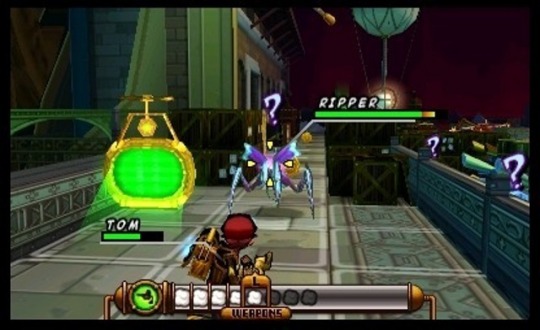
Seen here: Tom Sawyer about to get overwatched to fucking death.
You see, enemies inherently know their own ranges, so they’ll shoot as soon as you walk within it. But your weapons don’t really have an explicitly-stated range. Instead, as you inch closer to foes, you’ll eventually see their names and health bars pop up. That’s generally when you can start hitting your shots, but you can definitely still miss, especially for guns that shoot multiple shots per attack. There are no indicators for how and when this will happen, just a hidden dice roll that will sometimes bend you over at random. Some weapons, like artillery explosives or pounce attacks do give you a trajectory indicator, but those weapons can’t use overwatch, so they’re more situational in use and can’t be relied upon entirely.

Weapon ranges are too abstract, except the ones for artillery apparently.
But what’s it really matter anyway when you don’t know how effective your shots will be even if they do connect? Sure, you can see an enemy’s health bar, and you can also see how much of a chunk you’ll take out of it will a full hit, but you’re only given a hard number for your damage when you hit, and you’re never given any numbers about the enemies’ health. OK, my Eagle Rifle can do 25 damage per bullet, and yeah, if I squint my eyes at the tiny health bar on the tiny screen, that looks like it might be taking off about 30% of their HP, but we’re dealing with some very fuzzy math here, which leads to more shrugging and guessing than calculating and risking. It’s a system built on almost entirely on feel, which isn’t ideal when your game feels awful. Is basic subtraction also too abstract, Paul?
There are lots of other annoyances as well. Enemy turns take forever (even after the dev patched in a speed up switch after launch), and because you have no tactical map of any kind, you mostly spend enemy turns looking at walls or empty hallways as the game moves patrols around for 10-20 seconds every time. The presentation is grating, with the same voice clip yelling “PLAYER TURN” and “ENEMY TURN” at the beginning of Every. Single. Turn. The character design is fine, I guess. The Silver Age comic look’s big, black outlines do help to make the models pop on the small screen. But also, the first two characters they give you are Henry Fleming (based on the character in The Red Badge of Courage), and the folk hero John Henry. Why they give you two guys both named Henry right off the bat, I have no idea, but it is stupid and confusing when someone yells “Henry,” and I don’t know who they’re talking about, which they do a lot in the beginning of the game.

Ah yes, swords: The perfect weapon in a shooting game.
Because this game is on the 3DS and is made by Intelligent Systems, it does have some amiibo support. You can scan in four different Fire Emblem amiibo (the four that were out at the time of the game’s development: Marth, Ike, Robin and Lucina) to get their corresponding playable characters in Code Name. For a bunch of sword fighters, they do surprisingly well in fights, but they do have a very odd drawback. If any of the Fire Emblem characters die in a mission, they leave your team completely and can’t come on another mission unless you scan that amiibo again. I can’t decide if that’s a permadeath reference for a core mechanic in Fire Emblem games or if that’s a way to encourage you buy the amiibo rather than just borrowing them from a friend one time to unlock the goodies, but either way, I can tell you it’s very annoying to have to carry around four amiibo on the off chance one of them bites it while you’re out and about.
I think it’s admirable to try and make a strategy game that is accessible and approachable for people unfamiliar with the genre. But this isn’t it. Mario + Rabbids is that. Marvel Snap is that. Fire Emblem: Awakening and Advance Wars are that. SteamWorld Heist is that (it even has “steam” in the title, making Code Name: S.T.E.A.M somehow even more irrelevant.)
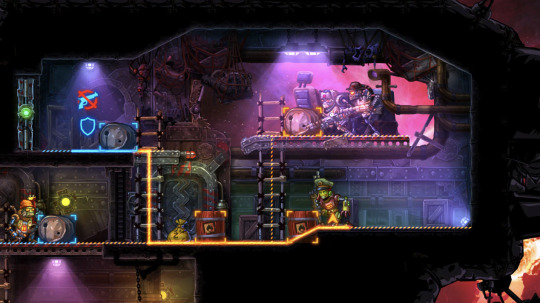
Play SteamWorld Heist instead. It's so much better!
Look, if you couldn’t tell by now, I think this game is pretty awful in almost every aspect. It’s very funny that Ulysses S. Grant can interact with Dorothy from The Wizard of Oz, and Tom Sawyer can ask questions about the Necronomicon, but the game all this silly bullshit is attached to is a boring, unintuitive and vague mess. I am baffled how a developer as good at making strategy games as Intelligent Systems is could make something so bad. And I hope I never have to think about it again.
4 notes
·
View notes
Text
GOTG Review: Mutant Year Zero
This is the next game in my Backlog Roulette series, where each month I spin a wheel to randomly select a game on my massive backlog that I must play (though not necessarily to completion). These wheel spins occur on the monthly preview episodes I co-host with my friends on The Casual Hour podcast.
I can’t remember the last time I shouted “oh, fuck off” as often as I did during my last Mutant Year Zero play session.
Mutant Year Zero: Road to Eden, the 2018 breakout turn-based tactical shooter from Swedish developer The Bearded Ladies Consulting, fools you into thinking you control the battlefield when in reality, the deck is eternally stacked against you.
If you’ve read or listened to any content from Gamers on the Go before, you’ll know I love this genre. Fire Emblem, Advance Wars, Super Robot Wars, XCOM, Into The Breach, Tom Clancy’s Ghost Recon: Shadow Wars (a criminally overlooked launch title for the 3DS) — these are the kinds of games where I feel most at home. But being a big fan of a genre can be a double-edged sword, because now I’m pretty particular about what makes a good one of these.
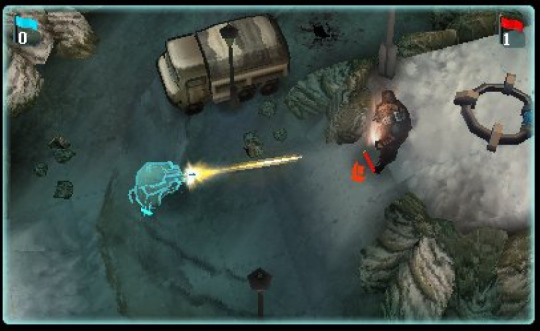
Tom Clancy's Ghost Recon: Shadow Wars was way better than it had any right to be.
Mutant Year Zero has some cool ideas, but it’s not "a good one of these." Your ragtag group of mutants — a pig man named Bormin, a duck man named Dux and a…normal lady who sometimes kind of has nature powers named Selma (you do get a couple more recruits over the course of the story) — are Stalkers, a group of capable hunters and scavengers keeping humanity’s last bastion of hope, the Ark, from the brink of collapse. Complicating this are Ghouls, who roam the post-apocalyptic Zone outside of the Ark, looking to bring the whole thing down. And you need to use your cunning and strategy to stop them while also finding Eden, a place that may be a salvation for the ruined world.
And therein lies my problem with Mutant Year Zero: my cunning just can’t make up for the amount of ways the game demands to fuck you over. One of the big selling points of MYZ is how you can explore areas in free roam until you or an enemy locks eyes and starts combat. This gives you an opportunity to pick up resources scattered around the environments or listen to your characters talk about the current events of the plot (which mostly involves Dux asking “isn’t this all kinda weird?” and Bormin saying “yeah, but shut the fuck up anyway,") but most importantly, it allows you to scout and position your units to ambush enemies for the next skirmish.
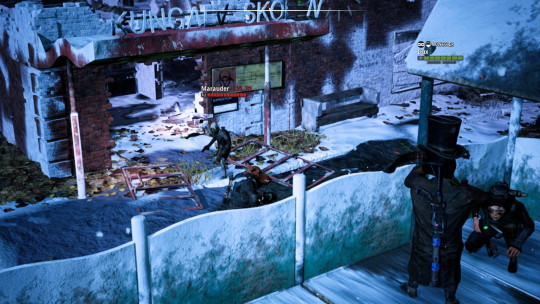
A snipe like this is the coolest the game gets, but it's nothing you haven't done a million times before in XCOM.
There’s something satisfyingly cool about posting my sniper up in an elevated position, then getting my tanky boar behind some cover down low to rush in and finish the job so that the enemies never know what hit them. This isn’t perfunctory either, as MYZ rewards you for being patient, doing a stealthy sweep of the area and even picking off a handful of stragglers with silenced weapons before it’s time to go loud and mop up whoever’s left. It’s a great system…when it works. But too often, engaging with these mechanics is a tedious or even impossible pain in the ass.
Tactical games all hinge on information. When you have information available to you, you can make smarter, more strategic decisions that let you take down bigger or stronger enemies. For example, in Into The Breach, you are given perfect information about exactly what each enemy is going to do on their turn even before their turn has started. So it’s up to you to find the best way of mitigating or redirecting their damage to protect your units and the city. Fire Emblem lets you turn on enemy range indicators so you can bait out some enemy attacks one at a time while avoiding the wrath of a full army. XCOM does hide enemies in a fog of war that are too far away, keeping you from getting the full picture of a battle, but it’s easy to scan around the field and position your units to make the best of what you have. Mutant Year Zero however routinely makes it difficult to know what you’re up against until it's much too late.

The first area you're in is a dense, dark forest. Then you get to this snowy area with so much crap on the ground that you can't really see anything effectively. And the zoomed out camera isn't doing you any favors.
The environments are incredibly dark, with plenty of debris to further block your view. Enemies have vision rings around them, but they don’t appear until you’re very close to them, making it nigh impossible to know if picking off this close enemy is going to provoke and enemy much further away. And there’s no map (mini or otherwise) to help you get a lay of the land. You do get a compass at the top of the screen that tells you where your objective’s destination is, as well as the direction of nearby enemies, but enemies also move around, and there’s no way to tag them to better keep track of where they go. But the worst of the issue of the bunch is an oppressively locked isometric camera that doesn’t ever seem to give you good sight lines of where you're going or what's out there. You can’t plan around what you can’t see, which often leads to your attempted ambushes getting ambushed themselves as more enemies you couldn’t detect come out of the woodwork to oppose you.
To make matters worse, even if you are able to fully scout out an area, there aren’t many opportunities to clear out those stragglers before the big firefight, even though that is kind of the game’s central thesis. Even when you do find them (which takes a significant amount of time, both with the game’s glacial walk speed, and waiting forever for enemies to get into the right position on their patrol path), the enemies in these situations can often take more than one round of combat from your stealth weapons, leaving them in a position to call in backup and/or retaliate with an attack of their own. But more often than not, enemies will be found in stubbornly stationary pairs, which further complicates your goal of a silent execution to remove a threat from the board. Why would they make a core tenet of their game so difficult to achieve? I don’t have a good answer for you, but it leads to a lot of standing around waiting for a plan to fail, only so you can reload and wait even longer for it to fail in a slightly different way.

Be ready to see this screen a lot.
Once the bullets do start flying, you’ll find yourself at a disadvantage almost immediately. Your attack ranges are painfully short, while the enemy seems to be able to take shots at baffling distances. Even when you do have a shot, good luck hitting anything. While MYZ certainly has some XCOM: Enemy Unknown influences — especially in its UI which will feel instantly familiar — one of the ways it tries to simplify is in its hit percentages. MYZ only deals in percentages of 100, 75, 50, 25 or 0. It all makes for a lot of missing, especially on your overwatch shots, leading to many wasted turns of missing, followed by more wasted turns of reloading your weapons. Meanwhile, a Pyro enemy is tossing molotovs at you like they were going out of style, and you’ll find yourself loading up your last save time and time again, leading to further frustration. I knocked the difficulty down to its easiest setting, and still routinely found myself in impossible, or brutally attrition-filled situations, and this is a style of game I feel pretty comfortable with!
It’s not quite all negative. The characters have pretty enjoyable personalities, both in their aesthetics and their mechanics, each with a unique skilltree of mutant abilities you’ll unlock over time (Bormin’s knockdown tackle is a personal favorite since it gave me another crucial stealth damaging tool, incapacitating a target long enough to follow up with two or more shots from my other characters, stealthily finishing the job.) And while the quantity of weapons in the game is low, the variety within that small set is very nice, with a number of distinct firearms with added abilities like knockdown or incendiary rounds. You can also find armor out in the world, which will cosmetically be displayed on your characters during play (I gave a top hat to Dux, not just for the increased damage buff it gives him while on elevated terrain, but also just because it looked dapper.)
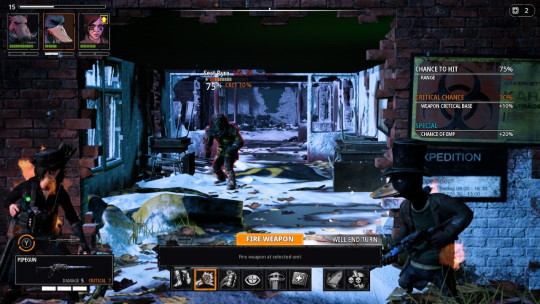
It's a good hat! But also, this is a 75% shot? From my sniper character? Give me a break.
But those niceties don’t make up for the molasses walk speed, poor autosaves, murky environments and painfully inaccurate weapons, which all combine to make for an experience that is equal parts exhausting and annoying, even in a game that’s as short as 10-15 hours. The Bearded Ladies new game, Miasma Chronicles looks like a big improvement to many of my MYZ complaints: The environments are cleaner, better lit and easier to both navigate and survey, which could make a huge difference in my enjoyment if I play it.
But Miasma Chronicles is not the game my backlog wheel landed on, Mutant Year Zero is. And I can't help but feel extremely disappointed. I’d heard many good things, and had often thought about playing it even before my backlog game required it. But unfortunately, a few fun ideas isn’t enough for it to rank in a genre packed with other excellent titles.
2 notes
·
View notes
Text
GOTG Review: Echochrome
This is the fourth game in my Backlog Roulette series, where each month I spin a wheel to randomly select a game on my massive backlog that I must play (though not necessarily to completion). These wheel spins occur on the monthly preview episodes I co-host with my friends on The Casual Hour podcast.
You want to hear something super lame? Echochrome is all about your perspective.
OK, maybe I should explain why that’s lame. Echochrome is literally a game about perspective. You rotate a camera to hide, reveal or alter the level’s geometry to coax a character you don’t directly control to navigate to specific areas of the map. It’s Lemmings in the style of an M.C. Escher.
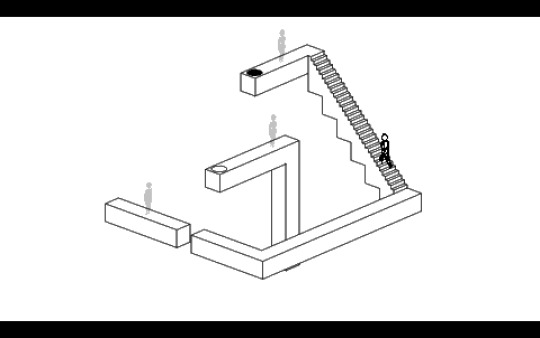
So when I say it’s a game about your perspective, that’s some on-the-nose, too-clever-for-your-own-good writer bullshit. Except that that’s not what I’m talking about.
The perspectives I’m talking about are not within the game’s clockwork levels, but outside of them. In the menus. In the presentation. In your approach to the game as a player as you hold your PSP and look upon it.
Echochrome does not function like a traditional game. You don’t go from Level 1 to Level 2. I mean, I guess you technically can, but good luck figuring out how. Because when you load up Echcohrome for the first time — after getting through its initial tutorial — you’re thrown into its main menu, greeted not by more expected options like “campaign” or “time trial” or “challenge.” Instead you’ll see the words “freeform,” “atelier,” “canvas” and my favorite “etc.”

Love it. No notes. Well, maybe just one note: What the hell do any of these things mean?
“Freeform” is the top option. Let’s try that. It dumps you into a puzzle. You solve it. You’re dumped into another puzzle. You solve it. Maybe this is a traditional game after all. But then you notice a letter and a number shown at the beginning of each puzzle. B4, F6, D1, C3. But you don’t think much about it. That is, until you reach a puzzle you can’t solve. One in which you realize the game has a 10-minute time limit per puzzle.

This is B8. I'm too stubborn to look up the answer, but I just can't figure out how to get the last echo. I hate it.
Cool, cool. While I think on that puzzle, let’s go back to the main menu and check out “atelier.” There’s no Ryza or Sophie to be found though, only a 8x7 grid of level options. And now the codes you saw on freeform make sense. Those were level identifiers. Row B, stage 4. Which means freeform is essentially a randomizer, whereas atelier presents them in the game’s natural order, of which you’re free to tackle any of the 56 stages however you wish. You go back to the one that stumped you before — B8. But after five minutes elapse, the failure bell rings. You only get half the time to complete a level in atelier mode (I guess because you chose the level yourself?)
And then there’s canvas — a neat little level editor to make your own stages — and etc., where the options, saves, credits and a replay of the tutorial go.
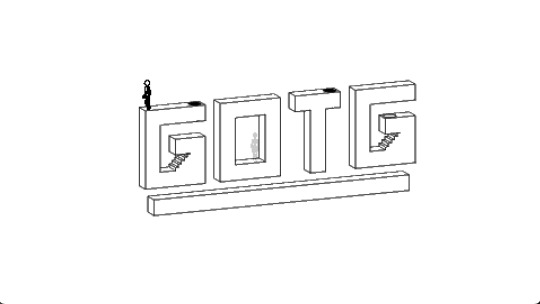
The game itself? Oh, it’s pretty cool, I guess. The perspective mechanics can feel a little inconsistent, requiring very digital outcomes through an analog control scheme. And the time limits feel rather pointless (if the game is already tracking your time on each puzzle like a score, then what’s the need for a limit?) in a game that should be as pleasantly relaxing as doing the daily crossword or sudoku. And it is equal parts frustrating and funny when the soothing disembodied lady voice says “oops” every time you let your Escher lemming fall off the world.

But more important to me is how the game bucks traditional names, rules and conventions to do its own thing (as the late Sony Japan Studio was wont to do with all their games), giving it a novelty and charm that endures to this day. Echochrome II though, requiring both a PS3 and a PlayStation Move controller to play, ages quite a bit worse unfortunately.
2 notes
·
View notes
Text
GOTG Review: Opus: Echo of Starsong
This is the third game in my Backlog Roulette series, where each month I spin a wheel to randomly select a game on my massive backlog that I must play (though not necessarily to completion). These wheel spins occur on the monthly preview episodes I co-host with my friends on The Casual Hour podcast.
Video games can be anything — from a complex web of interactions in something like Crusader Kings, to the twitchy, fast-paced action of a Call of Duty, even to the chill vibes of A Little To The Left — but should they be? Can you think of a time when you were playing a game and thought “this might be better as a movie/book/comic/TV show?” Because that’s kind of where I am on Opus: Echo of Starsong.
Opus is billed as a text-driven side-scrolling adventure game, which, while technically true, seems a bit generous. Outside of its quite pleasing aesthetic elements (interesting characters, a well-realized world, striking visuals and sound design), the rest of the game feels…kind of like an afterthought.
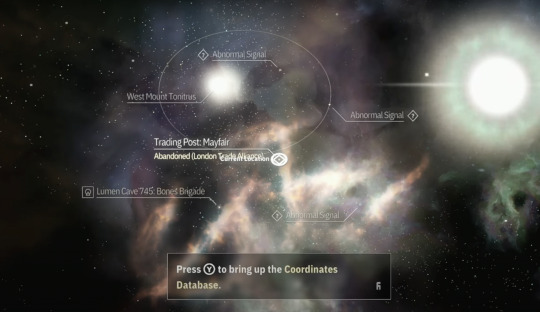
You can freely move your ship around space, but moving to a destination requires an amount of fuel equivalent to where you were last stationed.
In Opus, you travel around a solar system in a spaceship, talk to people and explore asteroids as you look for increasingly rare caves of lumen (the game’s energy source, basis for religion and handwaving catchall to explain literally anything). But all of these activities feel not just unfun, but so powerfully straightforward as to be mere busy work before the next story beat can be told.
Driving your ship around the stars requires fuel, and going from place to place can trigger FTL/Oregon Trail-style events. Maybe you’ll run into some pirates and lose some armor plating. Maybe you’ll find a guy who will give you a material with which to upgrade your ship. Sounds like some juicy push/pull risk/reward so far, but you’ll quickly come to realize it all just finds a way to even itself out. You always seem to have just enough resources to get by, and if you don’t, you can be sure you will after visiting one or two more stations along the way. I couldn’t even tell you if completely running out of fuel or armor plating is a lose condition because you’re just not ever put in that position.

The ship looks great, and the upgrades all show up cosmetically, but they don't really change the way you play the game.
You can upgrade your ship, sure, but you should know those upgrade aren’t really giving you a leg up or expanding your options: They’re just letting you keep up with the slightly higher numbers you’ll need for the next bit. Get a bigger fuel capacity? Lo and behold, your next destinations just so happen to be a tiny bit further out than before. Equip a part that gives you bonus points on your chance dice rolls? Now instead of a 2-in-6 chance, you have a 4-in-12. Lucky you.
Plus there’s the always fun “illusion of choice” dialogue options. Don’t expect any of your decisions to prove especially meaningful. Opus’s story, while well told, is not yours to tell, just to observe.
Even the game’s puzzles are devoid of challenge or interest. Move here. Select a thing. Move there. Select a thing. It’s less about “solving” anything, and more just going through the motions.

This is about as puzzling as Opus gets. Just line up the white lines with the pillars.
Which leads me back to my main question — Why is Opus: Echo of Starsong a game if all the game stuff is so flat?
The answer isn’t complicated: When video game developers make something, it tends to be a video game. The same way a movie studio is more inclined to make a movie rather than write a book. And people end up having different strengths and weaknesses. The team at SIGONO happen to be pretty good storytellers and visual artists, but maybe aren’t as good at the mechanical parts of a video game.

The game looks (and sounds) fantastic.
The devs seem to know the strengths of Opus too. Looking into the options menu before I started playing, I noticed an unusual one: You can individually switch on or off each character’s voice lines. The game presents it as a way to perform the game with a group, with each person taking a role of a different character, and the game filling in with voiced dialogue for whoever’s left over (though, do note, there isn’t any English voice acting, just Chinese and Japanese.) I think it’s a hell of a cool addition, but I wouldn’t put my friends through the hell of having to watch me fiddle with the most basic of inventory management before getting back to the next story scene.
Should Opus: Echo of Starsong be a video game? Maybe, but maybe not this video game. There’s a lot of cool stuff being done in the visual novel space these days. I think Opus could fit in pretty well there. But as is, I just don’t find the fun-to-tedious ration to be in its favor.
0 notes
Text
Chase Koeneke's Top 25 Game Boy & Game Boy Color Games
The final part in GOTG's GB & GBC Top 25 coverage, make sure you check out my good friend Giggy's list, as well as the shared list we made together on the most recent episode of the podcast.
While the NES was my very first brush with video games, it wasn’t until the Game Boy that I truly fell in love with gaming. For a kid who got taken on a lot of long car trips, it was a godsend (both to me, but probably even more so to my parents, who could drive in relative peace). I dumped hundreds of hours into many of these games, and some of them continue to rank within my all-time favorites.
25. Wario Land: Super Mario Land 3
24. Kirby Tilt ‘n’ Tumble
23. Pokemon Pinball
22. Tiny Toons Adventures: Babs’ Big Break
21. Metal Gear Solid (Ghost Babel)
20. Shantae
19. Harvest Moon 3 GBC
18. Balloon Kid
17. Mario’s Picross
16. Mole Mania
15. Mega Man V
14. Super Mario Land
13. Super Mario Land 2: 6 Golden Coins
12. The Legend of Zelda: Oracle of Ages
11. The Legend of Zelda: Link’s Awakening DX
10. Mario Tennis
I’m not usually a big sports game guy. I find the ways devs abstract a sport through mechanics interesting, but often, their efforts fall short. I’d prefer to just hitting the batting cages than play Game Boy Baseball, y’know? But that’s not the case with Mario Tennis. Camelot aced this one, with simple, responsive controls that offered hidden depth in its strategic play. And the light RPG elements let you shape your character to better fit your play style (then import that character into the N64 incarnation!)
9. Warlocked
I didn’t grow up with a PC, so the real-time strategy genre was always something of a mystery to me. Warlocked was the first RTS I ever got my hands on, and while I can’t say it’s a particularly glowing example of the genre, the fact it even works on a Game Boy Color is astonishing to me. I ran the wheels off this game, playing through both its campaigns and collecting all the colorful wizard characters (Sweatwiz for life!)
8. The Legend of Zelda: Oracle of Seasons
Zelda continues to not be my thing, but the Oracle games are generally my favorites of the entire franchise (which feels wrong since they’re made by Capcom). Of the pair, I prefer Seasons’ mechanics. Plus, I really love exploring Subrosia — a volcanic land sitting right below the overworld — and interacting with its Jawa-looking residents. Most people are going to prefer Link’s Awakening, and that’s fine, but for my money, Oracle of Season is the way to go.
7. Donkey Kong ’94
It’s unfair how good this game is. The movement tech Mario can achieve is unreal, and it forever changed the way we think about Mario’s moveset. If you’ve ever enjoyed the triple jumps of Super Mario 64 or the cap throwing and diving of Mario Odyssey, you have DK ’94 to thank for inspiring it all. This game takes the original arcade game, and expands it into one of the greatest puzzle-platformers of all time.
6. Tetris
It’s Tetris. I mean, what else needs to be said? Later versions have added slight tweaks to the formula in the form of T-spins or holding pieces that make them arguably better, but whenever I want to play some Tetris, this is always the one I reach for.
5. Kirby’s Dream Land 2
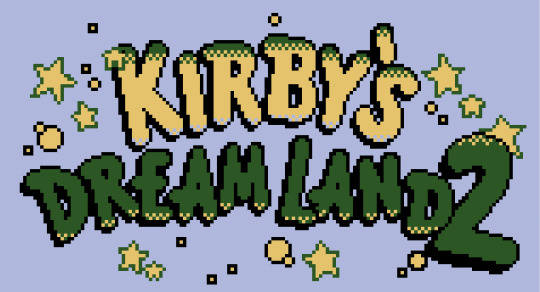
Creator Masahiro Sakurai has said the original Kirby’s Dream Land is all about introducing people to what a platform game is. Dream Land 2, in my opinion, is about introducing you to what they can be. The copy abilities brought in from Kirby’s Adventure are expanded threefold with the addition of Kirby’s animal companions, and the music from the battle with King Dedede still bangs. This will forever be my favorite Kirby game.
4. Mario Golf

I gushed about Mario Tennis above, but it can feel repetitive at times as you play set after set on nearly-identical courts. Mario Golf brings in everything good about Tennis (the RPG elements, character importing, great controls) and applies it to a sport that naturally has a little more variety through its courses, challenging you to approach them in different ways. Pick up both if you can, but if you only have room for one, Golf is the way to go.
3. Pokemon Gold/Silver/Crystal
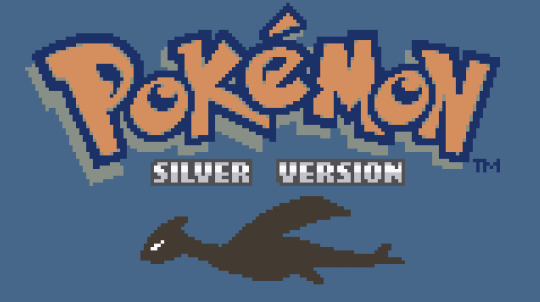
The second generation of Pokemon games add so much to the series, both from a mechanical perspective with new types, held items, additional HM moves, breeding and more. But maybe more importantly, Gold, Silver and Crystal surprise and delight in a way that make you feel like you’re in a living and breathing world. It can be annoying for those going back to the games now, but having a real-time day and night cycle affecting the Pokemon you could catch felt revolutionary. And weekly events like the bug-catching contest or a Lapras that only appeared on certain days made you want to explore (and re-explore) every area in the game. Last, but certainly not least, going back to Kanto in the postgame continues to be one of the coolest surprises a game can throw at you.
2. Pokemon Red/Blue/Yellow
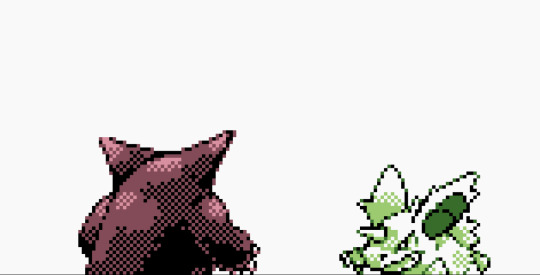
…But even if all of the above is true, it’s not the original. Red, Blue and Yellow, while often a broken, buggy mess, got so much right on their first try. I think a lot of it is the sense of ownership I got through playing. When you pick up a Mario or a Zelda game, you’re playing as those characters, escaping into their shoes. With Pokemon, those were my shoes, and the creatures beside me were ones I raised and trained. It was all my adventure. And that made it all the more special.
1. Pokemon Trading Card Game
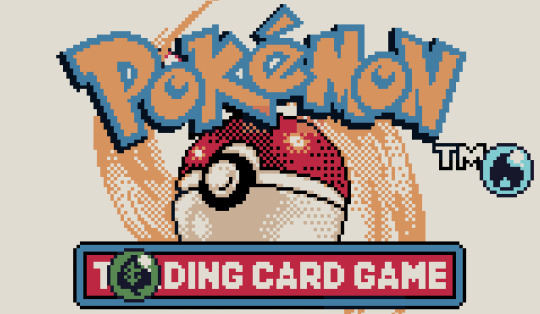
There’s something about card games though. All my Pokemon card friends just wanted to collect them, to keep them in binders and show them off. I always wanted to play the actual game, but would never have anyone to play against. That is, until this came out. Now I had a bevy of computer opponents to face off with, and every win would grant me the dopamine rush of ripping open virtual card packs to further enhance my decks. Even if the card game its based on is a little unbalanced, it’s still one of my favorite games ever, and my favorite Game Boy title of all-time.
12 notes
·
View notes
Text
Matt Giguere's Top 25 Game Boy & Game Boy Color Games
Ed. note: Thanks to “Giggysan” for joining on GOTG’s GB & GBC Top 25 episode. The following list are his personal top games for the system, which include none of the restrictions we used in our shared list.
25. Boxxle
24. Shadowgate Classic
23. Balloon Kid
22. DuckTales
21. Super Mario Land
20. Shantae
19. Kwirk
18. Metroid II: Return of Samus
17. Final Fantasy Legend II
16. Kirby's Dream Land
15. Warlocked
14. Super Mario Land 3: Wario Land
13. Wario Land 3
12. The Legend of Zelda: Oracle of Ages
11. The Legend of Zelda: Oracle of Seasons
10. The Final Fantasy Legend
While it may be a very basic RPG (you can make whatever party you want at the beginning) this game is no pushover. There are neat, but often obtuse battle mechanics that may put off those not willing to bend to the whims of the RNG gods, but I still find that as part of this game’s charm. For an early turn-based RPG on the Game Boy, the first Final Fantasy Legend is worth a look for what it accomplished in its time.
9. Super Mario Land 2: 6 Golden Coins
While a bit of a wonky platformer, Super Mario Land 2 manages to make for a very memorable and engaging time. The larger sprites make it easier to follow the action on screen, and while Mario might feel a bit floatier than usual, it still manages to be a solid game from beginning to end.
8. Final Fantasy Adventure
While not as good or transformative as Link’s Awakening, FF Adventure gets points for trying to bring the Zelda formula to the portable screen when few were tapping into that well. Just like Awakening, there is a full adventure to be had with this one, and a surprisingly engaging story.
7. Gargoyle’s Quest
A special little early Game Boy game from Capcom that is surprisingly deep for its time. Mixing both platforming and a character who levels up, this might feel like home to fans of the Adventures of Link on the NES, but here Gargoyle feels a bit more competent with its blend of genres.
6. Mario Golf
THE sports game to grab for the Game Boy Color. Somehow, Camelot made the best feeling and most fulfilling golf game on this small portable, and it remains as one of the best sports games made today.
5. Kirby’s Dream Land 2
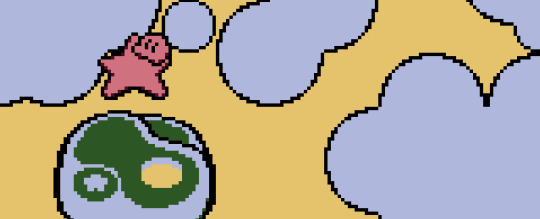
While the first Kirby game on Game Boy started the series, it was Kirby on the NES that gave him his personality. Dream Land 2 expands upon the NES game with animal companions that add a dual layer of mixing and matching abilities. It offers a feature-rich Kirby game right in your pocket with all the charm of the originals.
4. Donkey Kong '94

A surprise to be sure, but a welcomed one! Donkey Kong '94 is one of the most pleasant surprises on the Game Boy that, on its face, would have been a very decent port of the original arcade game from 1981. Instead, Nintendo flipped the script on the archaic moveset of Jumpman to make him feel more like modern Mario. There is also an astounding amount of content to be played here with just over 100 levels to test your puzzle-solving and platforming skills.
3. Pokemon Red/Blue
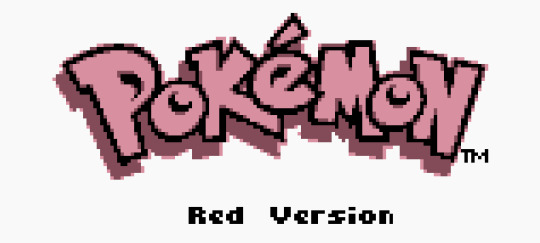
The games that started it all and spawned a billion-dollar franchise. While my love of the mainline Pocket Monsters franchise began and ended with this release, I still think back to the countless hours spent during recess with my friends grinding, trading and, most especially, battling each other to see who was the very best. Much like Link’s Awakening, Pokemon Red and Blue exemplifies how very little in terms of hardware power can produce a whole lot to play.
2. The Legend of Zelda: Link’s Awakening
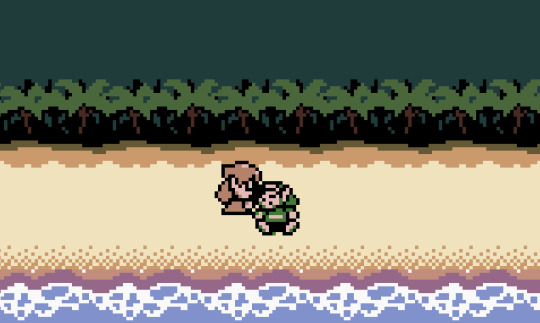
Link’s Awakening is a good example of how to get a lot out of something with so little by making a full-fledged adventure on a handheld with all the trappings of the home console versions. Few games can make the same claim that Link’s Awakening manages to pull off. Even though this game has been picked apart critically for years, it still remains fresh and a delight to play.
Tetris

You probably saw this coming like a desperately needed line tetromino on a five row setup. Yes, Tetris is one of the best games ever made. Yes, it is one of the greatest pack-in titles. Yes, it is one of the perfect examples of handheld and on-the-go gaming. Kids played it. Their parents and siblings played it. Everyone, for a time, played Tetris on a Game Boy. Tetris and the Game Boy are linked to the hip, and for that it deserves the number 1 spot.
6 notes
·
View notes
Text
Gamers On The Go's Top 25 Game Boy & Game Boy Color Games
On the off chance you don't have 2.5 hours to listen to a podcast where Chase Koeneke and Matt "Giggysan" Giguere debate and deliberate over our shared GOTG list of the best Game Boy and Game Boy Color games of all time, here's the ordered list of 25 we came up with.
Same criteria we used in previous lists:
One game per series (only one Super Mario Land
No ports (so something like Dragon Warrior III didn't count)
Total remakes were allowed (is DK'94 a remake? Who knows?)
Only official North American releases
Look for Chase and Matt's personal lists later this week.
25. The Game Boy Camera

24. Metroid II: Return of Samus
23. Metal Gear Solid (Ghost Babel)
22. Mario's Picross
21. Mole Mania
20. Pokemon Pinball
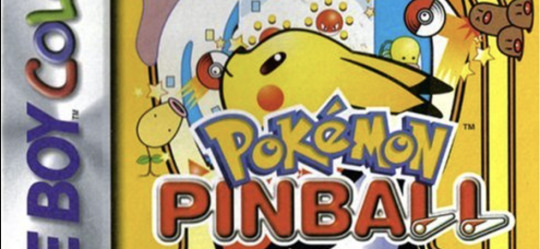
19. Kirby Tilt 'n' Tumble
18. DuckTales (Giggy assures me it has different levels from the NES)
17. Mega Man V
16. Kwirk
15. Shantae
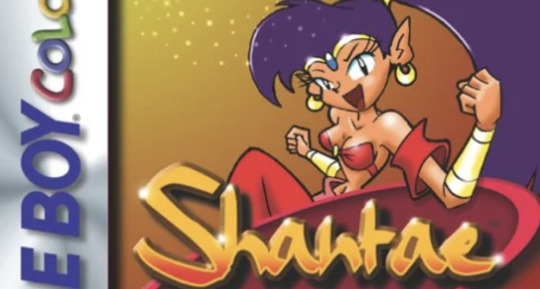
14. The Final Fantasy Legend
13. Mario Tennis
12. Warlocked
11. Final Fantasy Adventure
10. Wario Land 3

9. Gargoyle's Quest
8. Super Mario Land 2: 6 Golden Coins
7. Kirby's Dream Land 2
6. Mario Golf
5. Pokemon Trading Card Game

4. Donkey Kong '94
3. The Legend of Zelda: Link's Awakening DX
2. Pokemon Red/Blue/Yellow
Tetris

And be sure to check out our lists for the Top 25 GBA games, Top 25 DS games and Top 25 3DS games.
3 notes
·
View notes
Text
Episode 94: The Top 25 Game Boy & Game Boy Color Games
Subscribe to the show and listen here.
Chase and Matt “Giggysan” Giguere have one final era of Nintendo handheld consoles to rank, and it's the ones that started it all. Listen in as we run through our favorites and build our list of the best 25 games you can play on these portables.
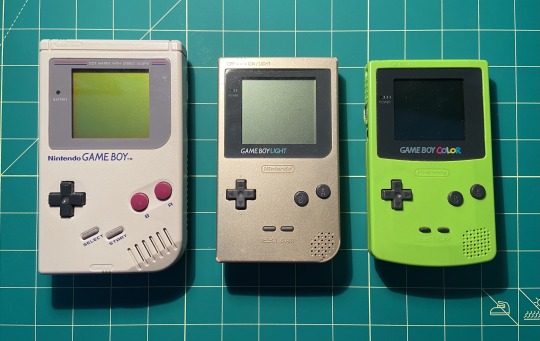
Same rules as before: Straight ports are frowned upon (sorry Dragon Warrior III), only one game per series and only official US releases were considered. We'll post the list of 25 later this week, then be on the lookout for personal top 25 lists from both Chase and Giggy.
0 notes
Text
GOTG Review: The Last Guardian
This is the second game in my Backlog Roulette series, where each month I spin a wheel to randomly select a game on my massive backlog that I must play (though not necessarily to completion). These wheel spins occur on the monthly preview episodes I co-host with my friends on The Casual Hour podcast.
I’m trying to remember the last time I felt genuine emotion for a character in a video game. Fire Emblem comes to mind. It is my favorite franchise after all. The idea of building up a roster of characters from zeroes to heroes. I celebrate their wins. I’m pained by their losses. But they don’t feel real. When one goes down, I mourn the loss of their utility more than I do the loss of their character.

I may not feel genuine emotion for Lapis as a character, but I sure do love when she does this.
Pokemon has a similar issue. I watch these monsters grow up and evolve over the course of my journey, my six faithful companions helping me take on the world. But the artifice never fully falls away. I see their “health points” and their mechanical abilities and am reminded these are still just bundles of data, and if I think about the numbers long enough, I can game them just right to always land in my favor. The closest I’ve felt to a critter in Pokemon is in the most recent entries, where Game Freak added in a chance to “hang on” with 1HP left after a devastating enemy move if your Pokemon’s friendship stat was high enough. It’s cool to see a Pokemon break the rules of the game through the power of love, but it also happens too often and too randomly for it to feel authentic.
Cliche as it might be, that last time that genuine feeling occurred might be Team Ico’s previous game, Shadow of the Colossus. Agro, your character’s horse was a constant and stalwart ally. Yes, it was mechanical in its own way, but in a game built around solitude, having this one thing on your side was a comfort, one that made the mostly empty world a little less lonely. And while Shadow of the Colossus plays on this attachment in a few key moments, Team Ico’s third game, The Last Guardian, is built entirely in service of this interaction.

Reductively put, The Last Guardian is the video game embodiment of “a boy and his dog.” You control a nameless boy, waking up in a prison of a cave. But you are not alone. There is a creature locked in here with you — a massive griffin-like animal. Chained, injured and afraid, it lashes out whenever you come near. This is Trico, and while you might not know it yet, this monster is going to become your best friend.
Trico is the whole reason The Last Guardian works. His appearance may be fantastical, but his movements, his mannerisms, his stubbornness — they are familiar. You look at Trico, and you know he’s made up of polygons and AI "if/then" statements, but that artifice just melts away, expertly hidden by characteristics that are innately animalistic. Trico barks at things he doesn’t understand. He looks at you in confusion as you try to coax him to move. He paws at his food. He stretches his legs after escaping cramped quarters. He shakes the water off him when he comes out of water and then he preens his feathers. It’s magic. And the developers are able to keep up this trick throughout the entire 12-hour experience.
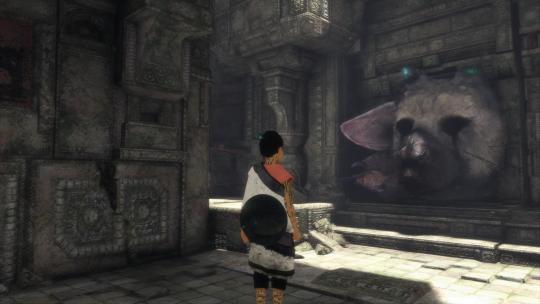
How could you not love this goofball?
The game around it however, can leave something to be desired: An awkward camera that’s both rigid and yet has a mind of its own, scenarios that go back to the well a few too many times (I can’t tell you how often my character blacked out due to story reasons, only to be woken up in a new area by a rescuing Trico) and world design that, while undeniably beautiful, is often confusing and repetitive.

But while those things can (and will) frustrate you, they can’t stop the emotion you feel for Trico. Never have I spoken so much to a TV during a playthrough, using the same tone as I would with my own pet. “That’s right, just a bit further. You can do it.” “No, not that way, Trico.” “Oh, you’re hungry now?” “There, there, the bad guys are gone. Nothing to be afraid of.” I caught myself saying these little phrases often, then laughing at how the game had fooled me yet again that Trico was a living, breathing thing.
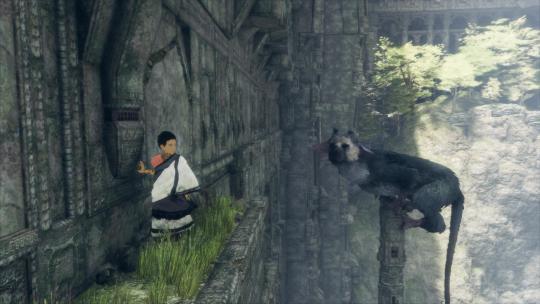
The Last Guardian definitely has its moments of intentional heartstring-pulling — big set pieces and scripted events with you or Trico put in a tight spot just to miraculously have the other save them at the most critical of times. And those moments do often land with their intended impact. But it’s the quiet moments that give Trico, and The Last Guardian by extension, its heartbeat.
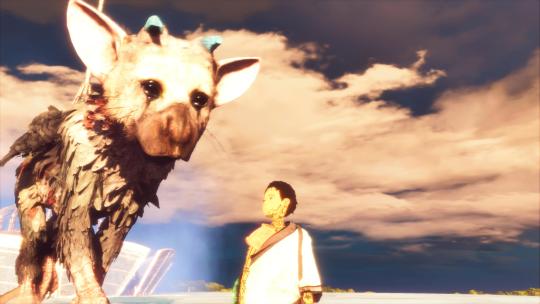
I have played and will play hundreds of games that are “better” than The Last Guardian. Games with sharper controls, more layered stories, nicer graphics, smoother framerates and less obnoxious puzzles. But few games will leave the impression The Last Guardian has. Because despite its flaws (and perhaps, even thanks to them), The Last Guardian made me feel something in a way that most games can't.
13 notes
·
View notes
Text
GOTG Review: Legend of the River King
In 2023, I’ve decided to make a real effort in clearing out my massive and ever-increasing backlog of games. To assist with this I built something I like to call Backlog Roulette.
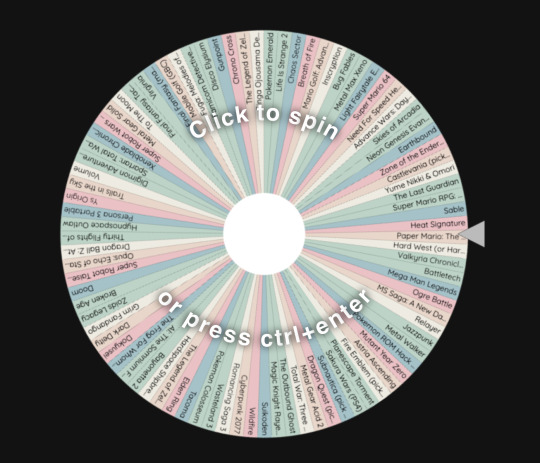
Each month I’ll spin this wheel during the monthly preview episodes of a podcast I co-host called The Casual Hour, and I will play whichever of the 90+ games Lady Luck selects for me. I don’t have to finish every game chosen, but I do need to give them “the old college try.” You can watch me explain the concept and rules if you’re interested, but the other thing of note is I want to write about each game here on GOTG. And the first game that came up was 1998’s Legend of the River King for the Game Boy.
Legend of the River King is a fishing RPG developed by Victor Interactive Software and published by Natsume (which is probably why it gives off some strong Harvest Moon vibes from its visuals).
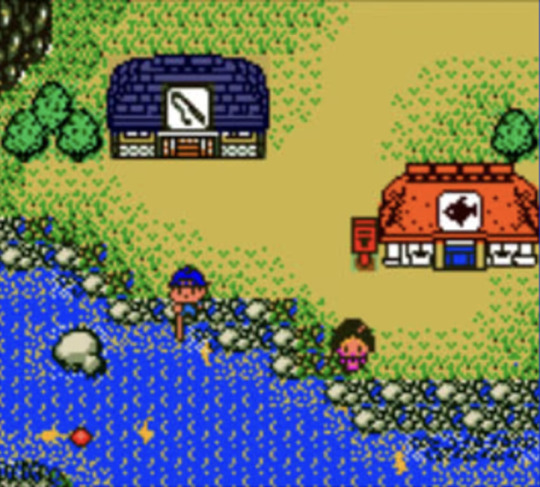
I think fishing games are fascinating in the same way I think golf and baseball video games are fascinating. It’s interesting to analyze the different ways designers handle their mechanics, how they view the act of casting a rod, throwing a ball or swinging a club through a controller. Whatever method they land on, it’ll never be quite like the real thing, but that layer of abstraction can be its own form of fun.
That’s uh, not really the case here with Legend of the River King. Its mechanics are tedious, arbitrary, confusing and often frustrating. Its options are too deep and its systems are too shallow. I wrote almost 600 words about the arcane way you select your bait and tackle, how the game includes a way to basically bypass all of its most intriguing mechanics and the pretty, but dead simple mini-game you play every time you hook a fish, but it was about as fun to read as Legend of the River King was to play, so instead, let's talk about the deeper issue here.
youtube
That deeper issue is the game's use of tension, and I can’t understand why the developers put so much of it into Legend of the River King. For a fishing game set in a tiny, slow-paced, generally carefree world, you are often put on edge. Some of this tension is believable and low stakes, like running out of bait or having a full pail of fish and needing to return to town. But some of it feels weirdly punitive, like random wild animal JRPG battles that can ether knock you out, steal your fish or both. Or your raft (a crucial part of you traversing the world) actively diminishing your health every time you use it, which is often! There’s even a manufactured story tension of needing to catch a specific fish to cure your sister’s illness (though thankfully no time limit is put upon you to get that medicine).
But for all this tension the game piles on you, none of it results in anything really meaningful. If you get knocked out by an animal or collapse from exhaustion on your raft, you’ll just wake up at the last inn you visited (though, in an odd bit of design, you'll be at 1 HP, requiring you to stay at the inn again to fully heal). You don’t even lose the fish you caught. The worst thing that can really happen to you is that a monkey steals a fish in a random battle that you were going to deliver to a quest giver, but it just creates more busy work rather than something that truly affects the gameplay experience. I suppose if you completely ran out of money and couldn’t buy new bait or lures, you could theoretically hit a failstate, but that’s never really an issue.
So with that in mind, is Legend of the River King supposed to be a chill fishing adventure, or is it supposed to be a test of survival against a harsh world that doesn’t want you in it? The game can’t decide, and leads to a mess of a 6-8 hour experience.

And while I’m pretty down on the game generally, I do have to admit there is the foundation of something cool here. The art (especially the underwater scenes featuring nicely detailed fish sprites and a very impressive parallax scrolling effect) is quite good, and the music is great. And when it wasn’t slowly sapping my health away, I liked exploring the world and mentally noting which fish show up where (but man, could this game have used a map).
Legend of the River King is a long-running series, with at least four of its titles having come over to the west, so I have to imagine Victor Interactive Software figured out the formula at some point. I’m not sure I’ll be putting Legend of the River King 2 on my backlog anytime soon, but I could also see myself taking the bait once again at some point.
3 notes
·
View notes
